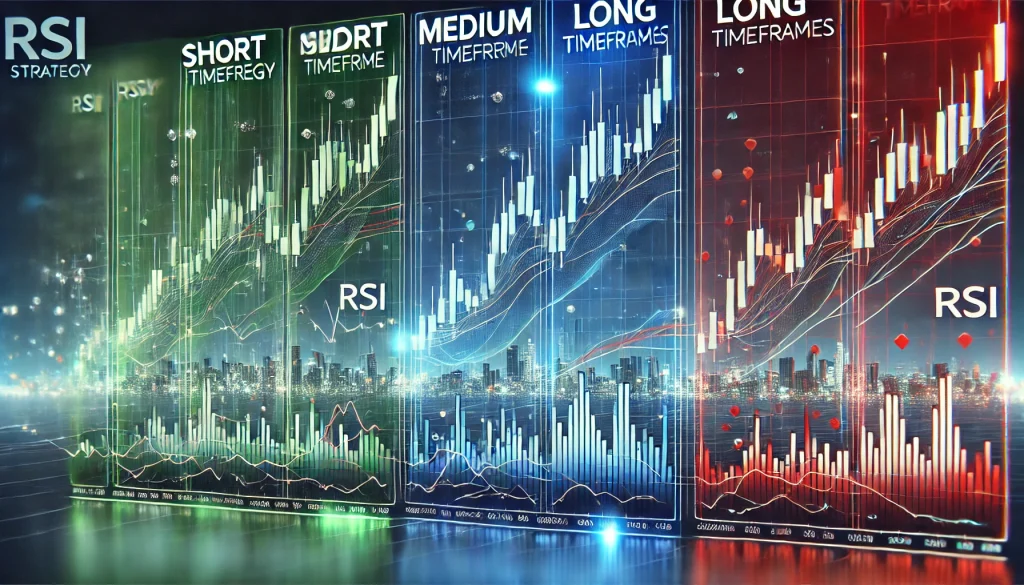
17 October 2024 Thursday

Memecoins Surge as “Peanut the Squirrel” Becomes a Viral Icon in Solana’s DeFi Market

Relative Strength Index (RSI): A Comprehensive Guide to Understanding and Using This Indicator

Wall Street Awaits AI Payoff as Tech Giants' Capex Soars Ahead of Fall Earnings


The Relative Strength Index (RSI) is a cornerstone of technical analysis and a vital tool for traders and investors alike. It helps identify the strength and momentum of price movements, making it indispensable for predicting market reversals and trends. This guide will delve deep into RSI’s components, its calculation, interpretation, and advanced strategies to elevate your trading to new levels.
The Relative Strength Index (RSI) is a momentum oscillator that measures the speed and change of price movements. Created by J. Welles Wilder in 1978, it oscillates between 0 and 100, indicating when an asset is potentially overbought or oversold. By providing a quantifiable measure of market sentiment, RSI allows traders to gauge whether a stock or other asset is trading at levels unjustified by the broader market trends.
RSI was introduced in Welles Wilder’s seminal book “New Concepts in Technical Trading Systems.” Over time, it gained immense popularity due to its simplicity and effectiveness in various markets, including stocks, forex, commodities, and cryptocurrencies. Today, RSI is a fundamental part of every technical trader’s toolkit.
RSI serves as a critical component in technical analysis, as it provides traders with signals of potential reversals, overbought/oversold conditions, and divergence trends. It complements other indicators like Moving Averages and MACD, making it a versatile tool for improving trading accuracy.

The formula for RSI is straightforward:
RSI=100−(1001+RS)RSI = 100 – \left( \frac{100}{1 + RS} \right)RSI=100−(1+RS100)
Where:
The result is a value between 0 and 100 that helps traders assess the strength of price trends.
Manually calculating RSI involves dividing the average of upward price changes by the average of downward changes over a specified period, typically 14 days. This calculation produces the RS value, which is plugged into the RSI formula.
Wilder recommended a 14-period RSI as a default setting. However, traders often modify this to shorter periods (7 or 9 days) for more sensitivity or longer periods (21 or 28 days) for smoothing out the noise in long-term trends.

The RSI is interpreted by using two primary levels:
When the RSI reaches extreme levels (above 70 or below 30), traders often anticipate a market correction. However, overbought/oversold conditions alone are not always reliable indicators, as assets can remain in these zones for extended periods, especially in strong trends.
RSI divergence occurs when price movement contradicts the RSI. For instance:

In bullish trends, RSI often hovers between 40 and 80. Even if it enters the overbought territory, the price can continue rising, as RSI can stay elevated during strong uptrends.
In bearish trends, RSI tends to fluctuate between 20 and 60. A reading below 30 during a downtrend suggests an asset may be oversold, but traders should wait for confirmation signals to avoid acting prematurely.
During sideways or consolidating markets, RSI typically oscillates between 30 and 70 without crossing into extreme overbought or oversold levels. In such periods, RSI can be useful for identifying potential breakout points.

Bullish divergence occurs when prices reach new lows, but the RSI forms a higher low. This suggests a weakening downtrend and a potential upward reversal.
Bearish divergence occurs when prices reach new highs, but the RSI forms a lower high. This indicates a weakening uptrend and the likelihood of a downward reversal.
Hidden divergences are subtle signals that suggest trend continuation rather than reversal. A bullish hidden divergence occurs when prices form higher lows, but RSI forms lower lows, implying continued upward movement. Conversely, bearish hidden divergence points to continued downward movement.

Both RSI and MACD are momentum indicators, but while RSI measures the speed of price movements, MACD tracks the relationship between two moving averages. RSI is better suited for identifying overbought/oversold conditions, whereas MACD is more effective for gauging trend strength.
The Stochastic Oscillator, like RSI, identifies overbought/oversold levels, but it compares closing prices to a range over a specific period. RSI tends to be more reliable for quick-moving markets, while the Stochastic is preferred for more detailed trend analysis.
Combining RSI with moving averages, such as the 50-day or 200-day MA, can enhance trading signals. For instance, using RSI as a confirmation tool when a price crosses its moving average can help filter out false signals.
RSI is an extremely versatile tool, but its effectiveness can be enhanced further when combined with other technical indicators. By using complementary indicators, traders can reduce the risk of false signals and improve their ability to pinpoint precise entry and exit points.
Bollinger Bands are volatility-based indicators that consist of a moving average and two standard deviations above and below it. When combined with RSI, Bollinger Bands help confirm whether an asset is genuinely overbought or oversold.
Fibonacci retracement levels are widely used to identify potential reversal points in a trending market. When combined with RSI, they can help traders identify whether a reversal is imminent.
Volume is a critical component of price movement. By combining RSI with volume indicators like the On-Balance Volume (OBV) or the Chaikin Money Flow (CMF), traders can gain insight into the strength behind price movements.

RSI’s flexibility allows it to be applied to various timeframes, making it useful for traders with different strategies, from intraday day trading to long-term investing.
In day trading, traders often use shorter RSI periods (e.g., 5 or 7 days) to increase sensitivity. Day traders use RSI to spot short-term overbought and oversold conditions, often looking for quick reversals.
Swing traders typically stick to the traditional 14-period RSI, using it to time entries and exits over several days or weeks. They often combine RSI with support and resistance levels to optimize their trades.
Long-term investors use RSI to identify broader market trends and long-term reversals. A 50-period RSI can smooth out short-term volatility and help investors identify larger market shifts.

Understanding the psychological aspect of RSI is essential for avoiding common pitfalls and improving trading outcomes. Traders often misinterpret RSI’s signals due to emotional biases like fear and greed.
When RSI reaches overbought or oversold levels, traders often make emotional decisions:
RSI can sometimes generate false signals, particularly in strong trends where the market remains overbought or oversold for extended periods. To avoid acting on false signals:
Despite its widespread use, RSI is often misunderstood or misused by traders. Below are some common mistakes and how to avoid them.
A common mistake is assuming that overbought or oversold conditions automatically indicate an impending reversal. In reality, an asset can remain in overbought or oversold territory for a long time during strong trends.
Another frequent error is relying solely on RSI without considering other technical indicators or market conditions. RSI should not be the only factor driving a trade decision.
RSI can produce misleading signals in certain market conditions. For example, in a strong bull market, RSI might frequently indicate overbought conditions, but the asset continues to rise.

Traders who want to get the most out of RSI can explore advanced strategies that go beyond basic overbought/oversold signals. These strategies can help traders spot high-probability trades in both trending and ranging markets.
The RSI swing rejection is an advanced trading strategy that adds another layer of confirmation to basic overbought/oversold signals. The strategy is as follows:
RSI failure swings are another powerful reversal signal. They occur when RSI fails to reach its previous high or low before reversing direction.
Just like price charts, trendlines can be drawn on RSI. Breakouts of RSI trendlines often precede breakouts in price, offering a leading indicator for potential moves.
Understanding RSI’s practical applications can be greatly enhanced by looking at real-world case studies. Below are examples from various asset classes, illustrating how RSI has successfully predicted market movements.
In 2020, RSI provided clear signals for several major stock market corrections. For instance, when the RSI of tech stocks like Apple and Tesla approached overbought levels above 80, subsequent corrections followed, as RSI predicted a short-term pullback.
Backtesting RSI over several decades of stock market data reveals that the indicator has consistently provided reliable signals for spotting overbought and oversold conditions. For example, during the 2008 financial crisis, RSI accurately predicted key reversal points in major indices like the S&P 500.
RSI has also proven highly effective in the foreign exchange (forex) market. Traders often use RSI to identify divergences and overbought/oversold conditions in currency pairs. In 2016, RSI successfully identified a major reversal in the USD/EUR pair, helping traders anticipate a 500-pip move.
RSI is a versatile tool that can be applied to a wide range of asset classes beyond stocks, including cryptocurrencies, commodities, and indices.
In the stock market, RSI is commonly used to detect potential price reversals. Traders often look for RSI divergence in individual stocks to spot when a trend might be losing momentum.
Cryptocurrencies are notoriously volatile, making RSI an essential tool for crypto traders. When Bitcoin’s RSI hits extreme levels (above 80 or below 20), it often signals the beginning of significant price moves.
RSI can also be used for trading commodities like gold and oil. Commodities often exhibit strong trends, and RSI helps traders determine when these trends are overextended and due for a correction.
Backtesting is crucial for refining any trading strategy, and RSI-based strategies are no exception. By testing RSI over historical data, traders can determine the indicator’s reliability and optimize their strategies.
Backtesting RSI involves applying your RSI-based trading rules to past price data to see how they would have performed. Traders typically use backtesting software or trading platforms like TradingView or MetaTrader to simulate RSI strategies.
Many platforms, such as Thinkorswim or TradeStation, provide backtesting tools that allow traders to automate their RSI strategy and simulate past trades. These tools also enable traders to tweak RSI settings and optimize their performance.
Backtesting can reveal how different RSI settings perform under varying market conditions. Traders may find that shorter RSI periods work better for day trading, while longer periods yield better results for swing trading.
The Relative Strength Index remains one of the most versatile and widely used technical indicators. Its ability to identify overbought and oversold conditions, combined with its simple calculation, makes it a must-have tool for traders and investors across all asset classes.
As markets continue to evolve, especially with the rise of algorithmic trading and artificial intelligence, RSI remains relevant. Traders are increasingly combining RSI with machine learning models and advanced algorithms to enhance its predictive power.
The Relative Strength Index (RSI) is a momentum oscillator used in technical analysis to measure the speed and change of price movements. RSI values range from 0 to 100, with readings above 70 indicating overbought conditions and readings below 30 indicating oversold conditions. It was developed by J. Welles Wilder in 1978.
The formula to calculate RSI is: RSI=100−(1001+RS)
RSI = 100 – \left( \frac{100}{1 + RS} \right)RSI=100−(1+RS100) Where RS is the average of x days’ positive closes divided by the average of x days’ negative closes. The most common time period for RSI is 14 days, but this can be adjusted to suit shorter or longer-term analysis.
RSI is interpreted by considering two key levels:
Above 70: Indicates that the asset may be overbought and could be due for a correction.
Below 30: Suggests that the asset may be oversold and could be due for a rebound. Additionally, traders look for divergence between RSI and price movement to spot potential reversals in market trends.
RSI is a momentum-based indicator, which tracks the speed and change of price movements, whereas other indicators like Moving Averages focus on the trend of price over time. RSI is often compared to the Stochastic Oscillator and MACD, with each providing unique insights into market momentum and trend strength.
Yes, RSI can be applied across various asset classes, including stocks, forex, cryptocurrencies, and commodities. While the interpretation remains consistent, traders may adjust the RSI settings depending on the asset’s volatility or the timeframe being analyzed.
One common mistake is over-reliance on RSI without considering other indicators or market context. Traders may also misinterpret overbought and oversold levels as definitive signals of reversals, when in fact, assets can stay overbought or oversold for extended periods during strong trends.
Relative Strength Index (RSI)